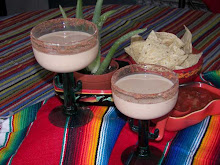

Photos by: Carlos Marentes
I've watched the Matachines dance in front of our neighborhood church since I was very little (a long time now!), but not until I started researching matachines did I understand the significance of the individual dancers.
As with the mariachis, the origins of the matachines are a little fuzzy. Even though they dance and host celebrations throughout the year, their most important performing season is Advent, mostly because the day of Our Lady of Guadalupe falls in that season on December 12th and she is celebrated starting in December and ending about one week before Christmas Eve. The dancers are known for a set drama based on the history of Montezuma. Even though the dances are based on this story, people who join the Matachines do it for a deeper religious purpose, since most of them join to venerate either Mother Mary (Our Lady of Guadalupe, Our Lady of Lourdes, Immaculate conception, etc.), a saint, or simply to worship Christ or God the Holy Trinity.
The dance itself is a portrayal of good versus evil, Christianity versus paganism. There is the leader called El Monarca. In Pueblo communities and tribes, the Monarca is said to have been Montezuma himself. There is La Malinche, this character represents innocence and is usually danced by a young girl dressed in a pastel colored dress or white First Communion dress. To balance out goodness, innocence and virginity, we have El Toro, the bull, portraying evil. To round off the atmosphere of the dance, you have El Abuelo, (the Grandfather) who used to scare young children into behaving and La Perejundia a man dressed as an old woman. In more recent times, El Abuelo and La Perejundia act more like comic figures than dancers to offset the solemness of the dance. The Abuelo, while joking around, keeps order and directs the different dances. The Perejundia, or La Vieja (old woman), plays around with the Abuelo and attempts to kill El Toro who represents evil.
Costumes vary from town to town and region to region. In El Segundo Barrio where I'm from, the matachines main color scheme is red with a picture of La Virgen de Guadalupe on the shirtfront or back. The dancers themselves make most costumes. Some dancers start at a very early age. I've seen four and five year old kids out there. With their youth, patience is required as the elders instruct them in the art of creating their costumes. This is an extraordinarily beautiful piece of work.
In the Segundo Barrio group of matachines, a drummer keeps the beat during lengthy dances. In other communities, a violinist and a guitarist accompany the dancers. Each dancer carries a guaje (rattle) in one hand and a three-pronged trident in the other.
Whatever traditions, beliefs, or customs have shaped the individual group of Matachine dancers in your own community, it is important to note that we each take pride in another aspect of our cultural heritage through the wonderful danza de los matachines (dance of the matachines).
If you would like to see an actual dance by the Matachines, check out this You Tube video. This particular group is from my home town - El Paso, Texas. I'm very proud of these dancers. They portray the essence of the beliefs we grew up with in the barrio and in all Chicano communities. Enjoy.
*********************************

GIVE CHOCOLATE FOR CHRISTMAS
Mi Chita's Mexican Chocolate Recipes
Buy Now, Click Here
*********************************
Mexican Word of the day..."CHALK"
"When she told me she was pregnant, I was in CHALK!"


11 comments:
What an interesting post. I love learning about history, cooking, other cultures, and this was a great "armchair" journey. Thanks Teresa!
I'm going to check out the You Tube video, but wanted to tell you how much I enjoyed learning about these dancers. A great post, Teresa.
Very cool info Teresa. I'm a big history buff, so I always like hearing about ancient customs. I like the good vs. evil concept, and am surprised at how much symbolism is used. Thanks buddy :)
Very interesting. Theresa I posted a question about purchasing the chocolate cookbook on your other site. Please check it out and get back to me. Gracias!
I love how dance is used in various cultures as a ritual of religious / spiritual significance.
Cool post. I love the colors in the pictures.
Thanks for the history lesson. Since I have only ever lived in the midwest and northeast it was really enlightening to me.
I had no idea you had a chocolate cookbook as well. Good for you!
Thanks for the interesting explanation, their costumes are gorgeous!
I love reading your blog because you always have such neat stuff on here! I always learn something!
I just love that mexican word of the day, it always makes me laugh out loud!!
This was fascinating! Thank you so much.
I was so glad I found your post. As a Mexican/American Catholic I should have known what matachines are. I, too, have seen them dancing since I was little even some of my CCD students are in the matachines ministry. I am such a gringa :P
Post a Comment